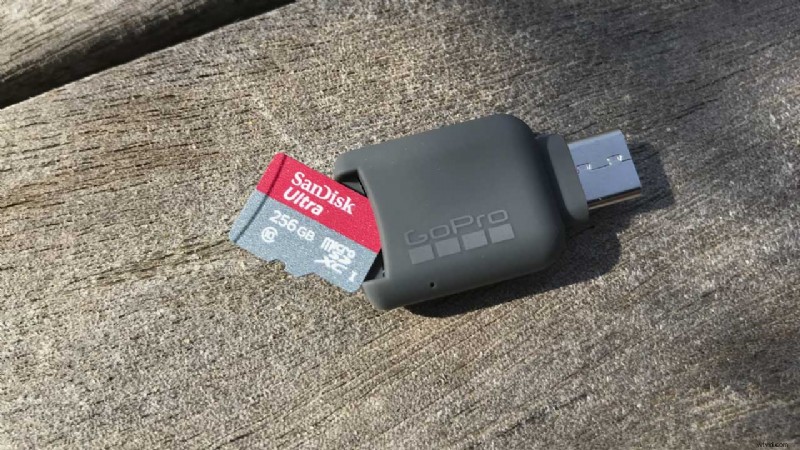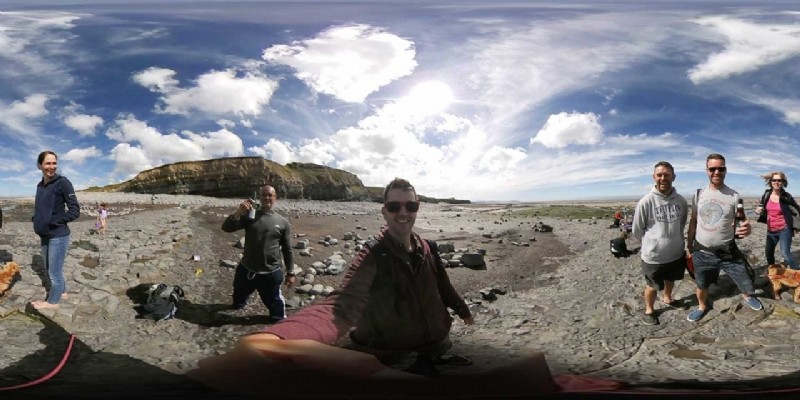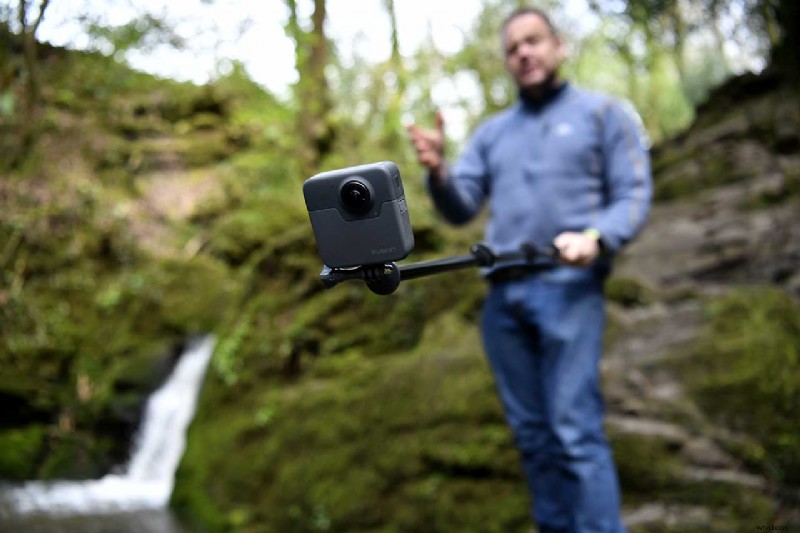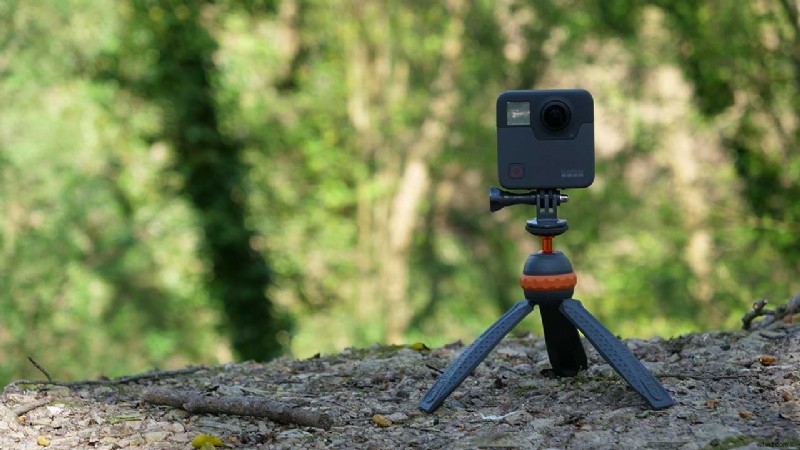De opkomende technologie in 360°-camera's heeft fotografen in staat gesteld scènes vast te leggen zoals nooit tevoren. Maar om deze 360-technologie ten volle te benutten, moet je op totaal andere manieren nadenken over compositie, belichting en enkele andere basisprincipes van fotografie en videografie. Er komt behoorlijk wat vallen en opstaan kijken bij het maken van 360°-video's en -foto's, maar hopelijk helpen deze 360°-cameratips en -trucs die we hebben opgedaan uit onze ervaring met het testen van de nieuwste technologie, om sferische inhoud te maken waar je trots op kunt zijn.
P>Heb je zelf een aantal geweldige 360-cameratips? Stuur ons een bericht en we voegen het toe aan de lijst met een tegoed!
01 Rechtvaardigt uw scène een 360-behandeling?
Een ding dat ze je leren over het filmen van video is om jezelf af te vragen:rechtvaardigt dit een video? Hetzelfde kan gezegd worden over 360 foto's en video's. Moet uw scène worden opgenomen? Is er interesse aan beide kanten van de camera? Biedt uw scène iets dat verder gaat dan het standaard gezichtspunt?
- Beste 360°-camera's in 2018

02 Gebruik een snelle microSD-kaart
Wat u moet weten over geheugenkaarten, is dat lees-/schrijfsnelheden grote invloed hebben op uw verwerkingstijden. De meeste 360°-camera's maken nu 4K-video, dus je hebt een geheugenkaart nodig die aan de eisen van deze resolutie kan voldoen.
Hoe sneller een geheugenkaart gegevens kan schrijven, hoe sneller uw verwerkingstijden zullen zijn. Waarom? Ontdoe u van de cijfers en de nomenclatuur en denk er eens over na:uw geheugenkaart is beperkt tot een bepaalde lees- en schrijfsnelheid en uw beeldmateriaal is voor altijd op deze snelheden vastgezet.
Je kunt die kaart in een high-spec computer en eersteklas bewerkingssoftware steken, maar ze kunnen de lagere snelheden waarmee de gegevens werden geschreven niet goedmaken als je koos voor de goedkope, maar trage geheugenkaart op een Amazon Lightning-deal.
- De juiste geheugenkaart selecteren voor je GoPro
Maar hoe weet je hoe snel een MicroSD-kaart is?
De allerbelangrijkste schrijfsnelheid van een kaart wordt weergegeven door de snelheidsklasse, de snelheidsklasse heeft betrekking op de minimale sequentiële schrijfsnelheid. Er zijn drie snelheidsklassen die in de loop van de tijd zijn gegroeid.
Oorspronkelijk was er de Speed Class 2, 4, 6 en 10. Deze klassen dicteerden dat de minimale schrijfsnelheden 2, 4, 6 en 10mb/s waren. Toen de eisen aan schrijfsnelheden toenamen, werd UHS Speed Class uitgebracht met U1 en U3, wederom met minimale schrijfsnelheden van 10mb/s en 30mb/s.
Meer recent zijn de V Video Class-kaarten verschenen met V6, V10, V30, V60 en V90 met minimale schrijfsnelheden van 6, 10, 30, 60 en 90mb/s.
Klasse 2 is de langzaamste en vrijwel verouderd, V90 is de snelste en nieuwste release die zo moeilijk te vinden en ongelooflijk duur is. Maak je geen zorgen, een klasse 10 of hoger is ideaal voor het opnemen van 4K 360-video.
Voordat we MicroSD-kaarten verlaten, is het ook vermeldenswaard dat niet alle camera's de capaciteiten van alle kaarten kunnen lezen. Dus hoewel uw 360°-camera mogelijk de nieuwste V90-kaart kan lezen, kan deze mogelijk een kaart van 1 TB niet herkennen.
Elke 360°-camera markeert het capaciteitsbereik dat ergens in de specificatielijst wordt herkend; neem de Garmin Virb 360, die een maximale kaartcapaciteit van 128 GB accepteert.
En 128 GB is wat ik zou aanraden qua capaciteit, als je budget het toelaat. Dit geeft je een beetje opslagflexibiliteit, zodat je niet constant bestanden van je kaart hoeft te verwijderen voordat je de kans krijgt om ze te bewerken.
- Wat zijn de classificaties van geheugenkaarten:Lexar beantwoordt vragen van fotografen

03 Plaats uw onderwerp voor de loden lens
Er is veel om naar te kijken in een 360-scène, en tenzij je een ruimtegevecht filmt of iets dat even vreemd en intens is, is het onwaarschijnlijk dat elke hoek, elk hoekje en gaatje van je scène een sterke visuele interesse zal bevatten.
Dus omdat elke geweldige video moet entertainen, moet je er vroeg bij zijn om de aandacht van je kijkers te trekken. Met de meeste 360°-camera's en bijbehorende software kunt u het gezichtspunt van een videobestand aanpassen. Door zich op de actie of emotionele interesse te concentreren, sluit iemand zich meteen aan.
Als je naar heatmap-gegevens van 360°-video's kijkt, zie je dat mensen niet vaak helemaal door een bolvormige scène vegen. Ze swipen totdat ze het interessantste vinden en blijven daar, om er dan misschien een beetje omheen te draaien om te zien wat er nog meer aan de hand is.
Vind dat interessante ding in je beeldmateriaal en verander je POV om het op de voorgrond te plaatsen. Je 360°-video's krijgen meer weergaven en langere kijktijden.
- GoPro Fusion vs Garmin VIRB 360:which 360 camera should you choose?
Framing your POV
I use ‘frame’ for the lack of a better word. In a 360-degree scene we’re not really framing in the old sense. The best 360 photos and videos are those that have a lot going on. And like a good header image for a blog post, you want to think about that initial point-of-view shot in the thumbnail that lures people in.
If you’re at a landmark or recognisable location, make sure that’s in the frame of the lead lens. Or if there is action going on, make sure that’s the first thing people see.
Sometimes it’s difficult to know which lens is the ‘lead’ lens. You can usually tell quickly by opening the app and looking at the live preview.
If your 360 camera’s app doesn’t have live preview, or if you’re not using it with the app for whatever reason, what I tend to do is shoot the video with the camera turned one way. Then I turn it around 180 degrees and shoot the same video again, switching the lenses. One of those will be correct.
You can often switch the POV in your editing software, as well.

04 Embrace the selfie stick
There was a point in time just a few years ago when the selfie stick represented vanity and everything that depressed us about pop culture. But over time the selfie stick, like the touchscreen LCD and even video itself, has proved its worth and become a respectable photographic tool.
For 360 photographers and videographers, the selfie stick is even more than that. It’s an essential camera bag stalwart that enables you to record from unusual angles and make more dynamic spherical footage.
Good selfie sticks, such as the Manfrotto Aluminium Extension included in its PIXI EVO VR kit, can extend quite high and give pseudo aerial views that immediately make a spherical still or video more dramatic.
Selfie sticks can also be used as the antithesis of their name:to keep you out of a shot. I’ll explain more about this in the next tip, but let’s just accept the fact that you, we, all of us together, we’re not interesting. Not usually, at least. And certainly not when we’re shooting 360 videos amid a stunning landscape or striking architectural wonder.
05 Stay away from the camera
Nothing spoils a 360 video or image like the sight of you, huddled over your phone pressing the shutter control, distracting from an otherwise interesting view.
It’s not entirely your fault. Or my fault. Our fault. We’re working with nascent technology, and the WiFi range of some 360 cameras is a bit limited, meaning you can’t get too far away and still be able to control them remotely.
To remove myself from the footage, what I tend to do is find something I can hide behind. A cabinet, or even inside a car, for instance. I’ve even crouched under a fallen tree and covered myself with brush. The things we do, eh.
But the key is really knowing where and when you belong in a scene. In a pristine landscape where you’re capturing waterfalls and endless bluebells and birdsong on your spatial audio, the sight of you jabbing at your phone is going to spoil the mood. So hide behind that tree trunk.
If you’re shooting a busy city scene, though, the sight of you there stationary amid the throngs of commuters could make for a nice juxtaposition.
- How to set up your GoPro Fusion
06 Be selective with your shots
In some ways shooting 360 stills and video has reminded me of the old days of shooting film. For a couple different reasons. For starters, some cameras are launched before their companion apps are fully developed, and this means that sometimes you’re shooting without the aid of live preview on your phone. This was the case with the Vuze camera, which I recently re-tested with its updated app.
Shooting blind means going on gut instinct and past experience, and in these instances I’ve founder fewer files is better until you establish a routine that you know works.
The main reason for selectivity with 360 video, though, is file size and processing time. My go-to 360 camera is the GoPro Fusion, which has fabulous image quality, but its 5.2K video files take up a lot of space on your microSD cards. They also can take an age to render.
Because of the size requirements and processing times, being more selective with your shots means that you’re spending time and space only on those clips that are important to you.
Being selective will also make your battery last longer.
- iPhone video tips:how to focus and improve exposure
- How to get started with iPhone video
07 Do you need 5.7K? Do you need 4K? Is Full HD enough?
With this selectivity in mind, ask yourself… do you really need to shoot in 5.7K or 5.2K? For that matter, do you even need to shoot in 4K?
Personally, I often shoot in Full HD. For my personal stuff, HD quality is good enough for sharing with friends and family. And it renders in a fraction of the time. And I can store it a whole lot easier.
Also think about your scene here when choosing your resolution. Are there a lot of fine details that you want to broadcast in crisp clarity? Well 4K or higher might be worth the extra investment of time and space.
If your scene is more about ambience or remembering a shared experience than fine details, shoot Full HD and you’ll have more time to share experiences!
- How to shoot a 360 timelapse video with the GoPro Fusion
08 Even light is your friend
360 camera technology is still improving, but one of its Achilles Heels is purple fringing in high-contrast scenes. If you can avoid them, do!
Many 360 cameras also have trouble capturing detail in heavy shadow areas because they don’t have the dynamic range that cameras with bigger sensors have.
Scenes that offer the best exposures are those with flat, even lighting. Depending on your subject, look for an overcast day to film that clip you’ve been wanting to capture.

09 You need a mini tripod
A lot of 360 cameras either don’t stand up on their own (the Fusion) or can do so but are susceptible to a slight breeze (the Ricoh Theta V).
A mini tripod not only keeps your 360 camera stable, but it opens up a world of creativity. I’ve stuck mine on the edge of a waterfall, the dash of a car with Blu-Tac on the feet, the roof of a chicken coop and other odd places. I also use mine as a grip and selfie stick.
Manfrotto’s PIXI range is very good, and GoPro provides a really nice tripod/grip with the Fusion, but my favourite mini tripod these days is the 3 Legged Thing Iggy, which comes with the standard screw mount and a GoPro mount, meaning I can use it for all my 360 cameras. I have too many 360 cameras.
10 Where to share your 360 photos and videos
One of the downsides of shooting 360 video and photos is that the web really hasn’t fully caught up with the functionality. Until recently you could shoot these amazing images and videos, but you could only post them on manufacturer’s dedicated sharing platforms, which none of your friends and family are one.
It’s gotten a bit better. Google Photos now supports 360 functionality. So does Facebook. And YouTube will play your videos in all their 360 glory provided they have some crucial metadata added to the file. Your camera’s 360 editing software typically does this during a render. Otherwise, Google has a free tool you can use to do the same job.
If you want to display your 360 images on your blog, I find that Kuula is a great resource. Simply create a free account and upload your 360 photo, then copy the shortcode and place it in your blog text. Job done. It’s what I use for my 360 camera reviews on this website.
- GoPro Hero 6 Black versus GoPro Hero 5 Black
- GoPro Hero6 Black versus Yi 4K+:wat is de beste actiecamera?
- GoPro Hero6 Black versus Garmin Virb Ultra 30:wat is de beste actiecamera?
